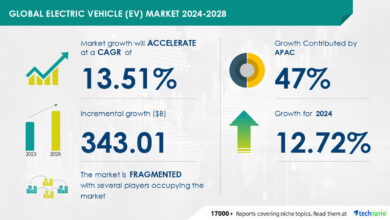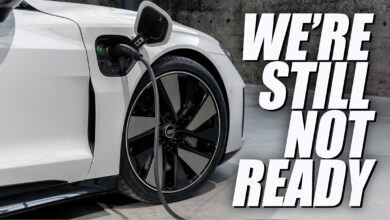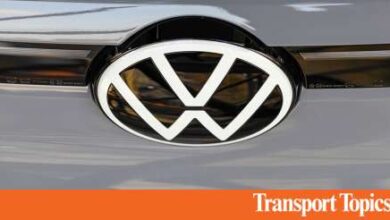Small, well-built Chinese EV called the Seagull poses a big threat to US auto industry

LIVONIA, Mich. — A tiny, low-priced electric car called the Seagull has American automakers and politicians trembling.
The car, launched last year by Chinese automaker BYD, sells for around $12,000 in China, but drives well and is put together with craftsmanship that rivals U.S.-made electric vehicles that cost three times as much. A shorter-range version costs under $10,000.
Tariffs on imported Chinese vehicles probably will keep the Seagull away from America’s shores for now, and it likely would sell for more than $12,000 if imported.
“Any car company that’s not paying attention to them as a competitor is going to be lost when they hit their market,” said Sam Fiorani, a vice president at AutoForecast Solutions near Philadelphia. “BYD’s entry into the U.S. market isn’t an if. It’s a when.”
The Biden administration on Tuesday is expected to announce 100% tariffs on electric vehicles imported from China, saying they pose a threat to U.S. jobs and national security.
The Alliance for American Manufacturing says in a paper that government-subsidized Chinese electric vehicles “could end up being an extinction-level event for the U.S. auto sector.”
Earlier this year, Tesla CEO Elon Musk told industry analysts Chinese electric vehicles are so good that without trade barriers, “they will pretty much demolish most other car companies in the world.”
Outside of China, electric vehicles are often pricey, aimed at a higher-income niche market. Chinese brands that are not yet global household names are offering affordable options that will appeal to the masses.
“The Western markets did not democratize EVs. They gentrified EVs,” said Bill Russo, the founder of the Automobility consultancy in Shanghai. “And when you gentrify, you limit the size of the market. China is all about democratizing EVs, and that’s what will ultimately lead Chinese companies to be successful as they go global.”
Company president Terry Woychowski, a former chief engineer on General Motors’ big pickup trucks, said the car is a “clarion call” for the U.S. auto industry, which is years behind China in designing low-cost EVs.
After the teardown, Woychowski, who has been in the auto business for 45 years, said he was left wondering if U.S. automakers can adjust. “Things will have to change in some radical ways in order to be able to compete,” he said.
There’s no single miracle that explains how BYD can manufacture the Seagull for so little. Instead, Woychowski said the entire car, which can go 252 miles per charge, is “an exercise in efficiency.”
Higher U.S. labor costs are a part of the equation. BYD can keep costs down because of its expertise in making batteries — largely for consumer products — that use lithium iron phosphate chemistry. They cost less but have a lower range than most current lithium-ion batteries.
BYD makes many of its own parts, including electric motors, dashboards, bodies and even headlights. It also has the advantage of its huge scale — 3 million vehicles sold worldwide last year.
“By having that all in-house and vertically integrated, there’s an incredible advantage that they have,” Woychowski said.
BYD designs all aspects of its vehicles with cost and efficiency in mind. For instance, the Seagull has only one windshield wiper, eliminating one motor and one arm, saving on weight, cost and labor to install.
U.S. automakers don’t often design vehicles this way and incur excess engineering costs, Woychowski said. Hoses, for instance, have to meet longstanding requirements in combustion engines for strength and ability to carry fluid under high pressure, many of which aren’t needed for electric vehicles, he added.
The weight savings add up, allowing the Seagull to travel farther per charge on a smaller battery. For example, the Seagull that Caresoft tested weighs 2,734 pounds, about 900 pounds less than a Chevrolet Bolt, a slightly larger electric vehicle made by GM.
So Detroit needs to quickly re-learn a lot of design and engineering to keep up while shedding practices from a century of building vehicles. The trick will be determining which procedures to keep for safety and quality, and which to jettison because they aren’t needed, he said.
“You’re going to have to come and be extremely serious about this, and you better park your paradigms at the door,” Woychowski said. “Because you’re going to have to do things differently.”
While the acceleration isn’t head-snapping like other electric vehicles, the Seagull is peppy and would have no problems entering a freeway in heavy traffic. Woychowski says its top speed is limited to 81 mph.
BYD would have to modify its cars to meet U.S. safety standards, which are more stringent than in China. Woychowski says Caresoft hasn’t done crash tests, but he estimated that would add $2,000 to the Seagull’s cost.
The company isn’t selling cars in the U.S., largely due to 27.5% tariffs on the sale price of Chinese vehicles when they arrive at ports. Donald Trump slapped on the bulk of the tariff, 25%, when he was president, and it was kept in place under Joe Biden. Trump contends that the rise of electric vehicles backed by Biden will cost U.S. factory jobs, sending the work to China.
The Biden administration has backed legislation and policies to build a U.S. electric vehicle manufacturing base. The administration also is investigating cars made in China that can gather sensitive information.
Some members of Congress are urging Biden to ban imports of Chinese vehicles, while others have proposed even steeper tariffs. This includes vehicles made in Mexico by Chinese companies that now would come in largely without tariffs.
Contributing: Paul Wiseman and Didi Tang

![Quality meets affordability (finally) [Video] Quality meets affordability (finally) [Video]](https://europeantech.news/wp-content/uploads/2024/05/1717091396_Chevy-Equinox-EV-hero-390x220.jpg)

